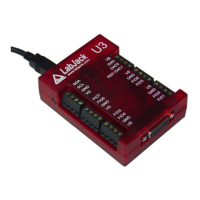3.2 Stream Mode
tact
ntinuous hardware timed
ifies
r
ffer is emptied, and then
The table below shows various stream performance parameters. Some systems might require
a USB high-high configuration to obtain the maximum speed in the last row of the table. A “USB
high-high” configuration means the U3 is connected to a high-speed USB2 hub which is then
connected to a high-speed USB2 host. Even though the U3 is not a high-speed USB device,
such a configuration does often provide improved performance.
Stream data rates over USB can also be limited by other factors such as speed of the PC and
program design. One general technique for robust continuous streaming would be increasing
the priority of the stream process.
A sample is defined as a single conversion of a single channel, while a scan is defined as a
single conversion of all channels being acquired. That means the maximum scan rate for a
stream of five channels is 50k/5 = 10 kscans/second.
Table 3-4. Stream Performance
Full resolution streaming is limited to 2500 samples/s, but higher speeds are possible at the
expense of reduced effective resolution (increased noise). The first column above is the index
passed in the Resolution parameter to the low-level StreamConfig function, while the second
column is the corresponding index for the Resolution parameter in the UD driver. In the UD
driver, the default Resolution index is 0, which corresponds to automatic selection. In this case,
the driver will use the highest resolution for the specified sample rate.
ENOB stands for effective number of bits. The first ENOB column is the commonly used
“effective” resolution, and can be thought of as the resolution obtained by most readings. This
The highest input data rates are obtained in stream mode, which is supported with U3 hardware
version 1.21 or higher. Hardware version 1.21 started shipping in late August of 2006. Con
abJack for information about upgrading older U3s. Stream is a co
L
input mode where a list of channels is scanned at a specified scan rate. The scan rate spec
the interval between the beginning of each scan. The samples within each scan are acquired
as fast as possible.
As samples are collected, they are placed in a small FIFO buffer on the U3, until retrieved by
the host. The buffer typically holds 984 samples, but the size ranges from 512 to 984
depending on the number of samples per packet. Each data packet has various measures to
nsure the integrity and completeness of the data received by the host.
e
Since the data buffer on the U3 is very small it uses a feature called auto-recovery. If the buffe
overflows, the U3 will continue streaming but discard data until the bu
data will be stored in the buffer again. The U3 keeps track of how many packets are discarded
and reports that value. Based on the number of packets discarded, the UD driver adds the
proper number of dummy samples (-9999.0) such that the correct timing is maintained.
Low-Level UD Max Stream ENOB ENOB Noise Interchannel
Res Index
Res Index (Samples/s) (RMS) (Noise-Free) (Counts)
Delay (
s)
0 100
2500
12.8
10.0 ±2 320
1 101
10000
11.9
9.0 ±4 82
2 102
20000
11.3
8.4 ±6 42
3 103
50000
10.5
7.5 ±11 12.5
42

